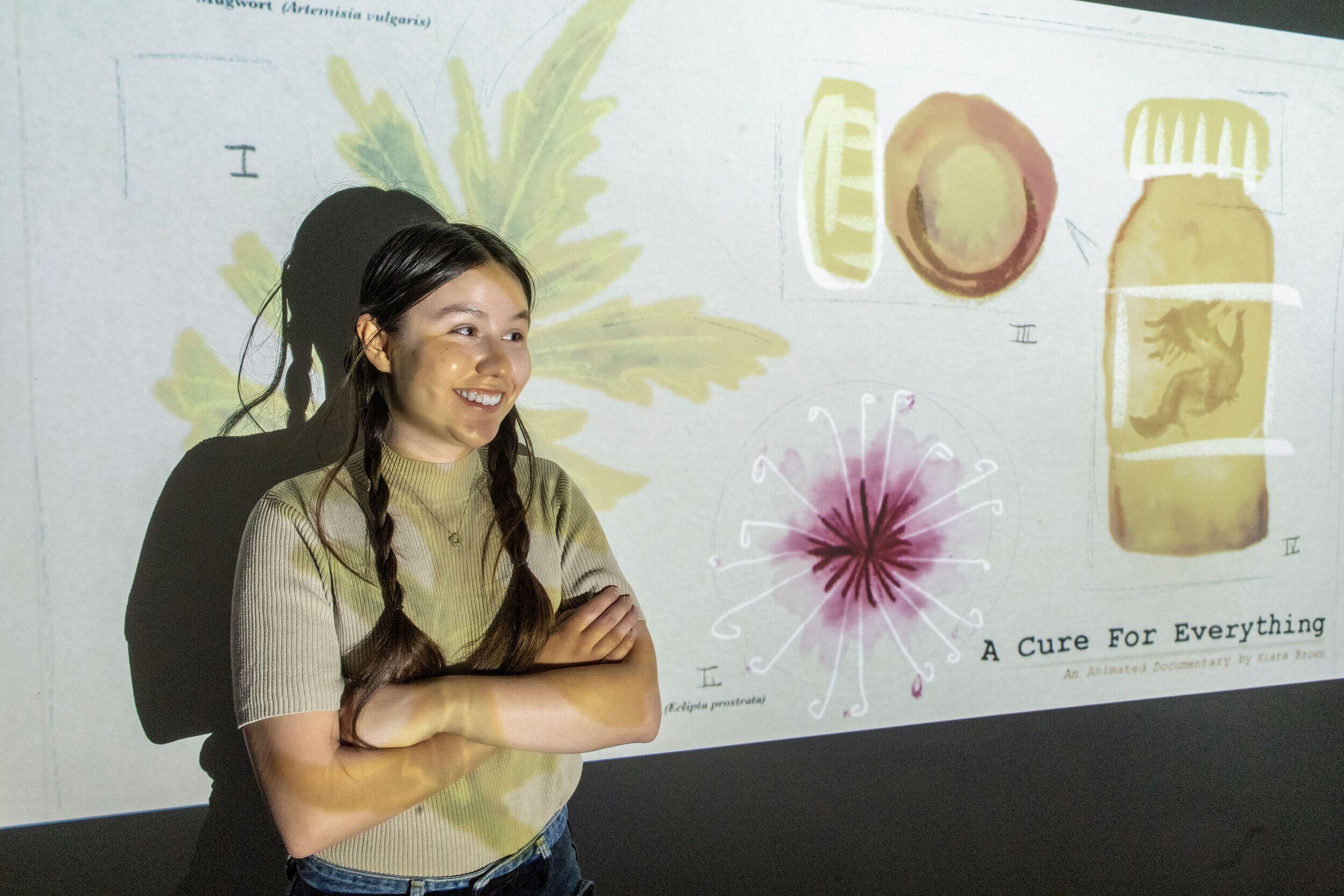
May 8, 2024
Class of 2024: Combining documentary and animation, Kiara Brown inventively explores family history and Vietnamese medicine
VCUarts student also used undergraduate research grant for artistic oral history project on Richmond locations.
Share this story
For someone who’s been on the dean’s list every semester since she came to the Virginia Commonwealth University School of the Arts, Kiara Brown considers herself a late bloomer to the art world.
“I’ve always been interested in creating things, but I considered myself primarily a writer who didn’t do visual arts whatsoever,” she said. “When I was in high school, I began drawing in order to create illustrations for a children’s book I was writing and got interested in illustration and graphic design through that.”
Brown enrolled at George Mason University planning to study environmental science or graphic design, but she wanted to expand her artistic horizons by studying sound art. So she transferred to VCU in fall 2021, and she graduates this month with a degree in kinetic imaging from VCUarts and a certificate in product innovation from VCU’s da Vinci Center for Innovation.
Brown’s interests evolved further at VCU – “my work is primarily documentary/interview/animation-based recently,” she said – and her inventive senior project, “A Cure for Everything,” combined all three elements. The experimental, animated documentary focused on a traditional, herbal, homemade Vietnamese medicine called dau phong.
“My family has been using it for generations as a miracle cure — it can heal scars, bruises and cuts seemingly overnight,” Brown said. “The person who made the medicine originally was a great-great-uncle of my grandmother who distributed it for free for the benefit of the community. After his unexpected death, the Vietnam War, the following diaspora and my own family’s immigration to the United States, we have lost the recipe.”
While the Brown family can still buy the medicine from distant relatives in Vietnam, the recipe is slightly different – and very expensive.
For the documentary, Brown interviewed her family about their experiences and the importance of the medicine and their heritage. She also worked with C. Michele Thompson, Ph.D., a professor of Southeast Asian history at Southern Connecticut State University, to learn more about the medicine’s origins, and VCU forensic science professor Michelle R. Peace, Ph.D., to try and identify the mystery ingredients.
“All of this is combined with interviews with my grandma, who is the only one who still remembers any of the recipe – but only remembers through the lens of a 5-year-old child,” Brown said.
Her documentary incorporates several styles, including stop motion, family photos, archival videos and 2D animation. An installation in March at The Anderson, the on-campus gallery of VCUarts, complemented the project.
“I took the information I had collected at that point and attempted to re-create the medicine as best I could,” Brown said. “I displayed the medicine cooking in a rice cooker, alongside mostly uncut, long-form interviews from my grandmother, the researcher and the forensic scientist, who all offered differing perspectives on the medicine. Behind this, I projected a large-scale shadow dragon representing the spirit of my ancestors guiding me in this project as I continued their work.”
During her research, Brown discovered that her family were the village healers, people who practiced traditional medicine in rural areas and passed down the recipes. That tradition continued when her great-great-uncle passed the recipe to her then 5-year-old grandmother before his death.
“As a tribute to that, I distributed small samples of my version of the medicine — as artwork, not a drug — at the installation,” Brown said.
Last year, she worked on another documentary that was just as meaningful to her for different reasons. She and a group of classmates received an undergraduate research grant from VCUarts for the Richmond Animation Archive, an oral history with a focus on local places that no longer exist, such as buildings that have been torn down or converted.
“It was really cool getting to talk to so many strangers and people we considered influential to our time here in Richmond,” said Brown, who directed the film, citing figures associated with entities such as All Saints Theatre and World Music Radio. “After we collected the stories, we storyboarded and created animations to document them.”
The project culminated in a free community animation night at the Institute for Contemporary Art at VCU last summer, where the group screened the animations and hosted related activities. A continuation of the work — a bit more polished version, with each story expanded — was screened at the James River Film Festival.
While Brown said her time at VCU was amazing, crediting her professors and classes for helping her grow as a person, she is especially grateful for her friends and classmates, particularly those with whom she worked on the Richmond Animation Archive.
“Getting to be around so many other artists who want to make great work has been the best part of being down here,” she said, “and I think we all push each other to grow as people and artists.”
Subscribe to VCU News
Subscribe to VCU News at newsletter.vcu.edu and receive a selection of stories, videos, photos, news clips and event listings in your inbox.












